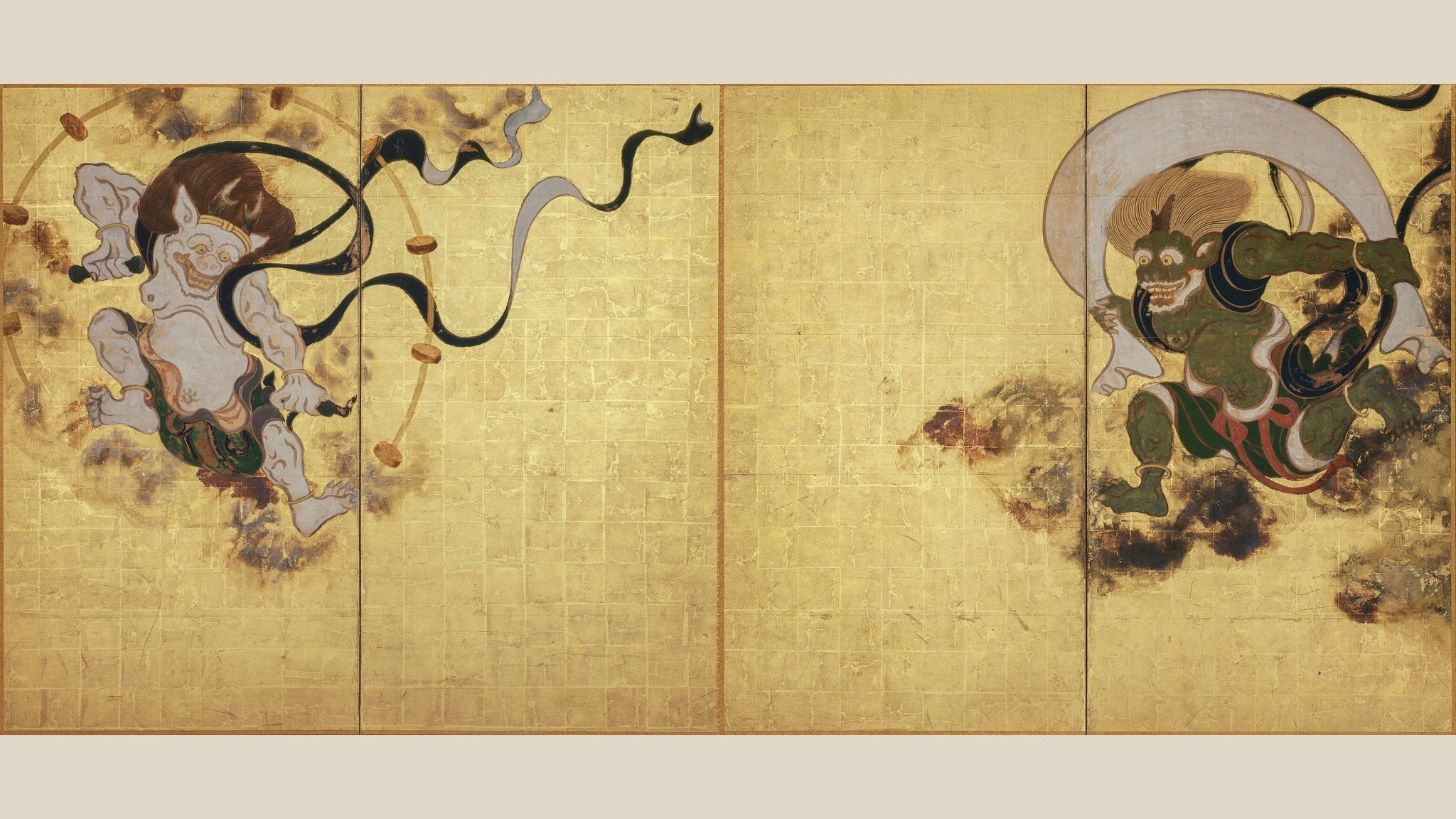
Elegance Reimagined: The Rimpa Legacy Through MUSUBI KILN's Collections
Written by Team MUSUBI
(Tawaraya Sotatsu. The Gods of Wind and Thunder. 17th century, 60.9 × 66.9″ (154.5 × 169.8 cm), Kyoto National Museum, Japan.)
The Rimpa school, an iconic movement in Japanese painting, emerged in the early 17th century, renowned for its vibrant use of color, elegant design motifs, and emphasis on nature and seasonal themes. Characterized by its unique blend of simplicity and opulence, the Rimpa school has influenced generations of artists and craftsmen, transcending time to remain relevant in contemporary design and aesthetics.
In this article, we delve into the modern-day celebration of Rimpa's enduring beauty through the collection of MUSUBI KILN. Highlighting a curated selection of products, each piece resonates with the distinct characteristics of the Rimpa tradition: the use of bold, simplified forms, lavish application of gold leaf, and nature-inspired motifs that speak to the soul of this historic art form.
table of contents
The Artistry of the Rimpa School

Rimpa creators mastered depicting natural scenes with stylized grace, focusing on the beauty of flora and fauna, seasonal landscapes, and classical literature motifs. The hallmark of the Rimpa style is its decorative quality, where gold and silver foil backgrounds illuminate vivid colors and bold patterns, creating a visually stunning effect that transcends time and place.
The legacy of the Rimpa school, enriched by its pioneers, continues to inspire with its celebration of nature's fleeting beauty, rendered through a blend of bold simplicity and intricate detail, capturing the essence of Japanese aesthetics at its most profound.
Yoshita Kasho Wave Beaten Beach Glass Natsume Matcha Container
The Yoshita Kasho Glass Natsume Matcha Container stands as a contemporary tribute to the traditional Japanese Rimpa school of art, blending modern design with classical aesthetics. This exquisite piece is inspired by the araiso motif, a poetic interpretation of the wave-beaten shore, capturing the Rimpa school's enchantment with the natural world.
The container's design, employing green lacquer to reflect the undulating waves against a meticulously assembled shore of mother-of-pearl shells, channels the serene and harmonious spirit emblematic of Rimpa creativity.
With its elegant mix of materials, including the use of keyaki wood and a protective layer over the gold leaf, the Glass Natsume Matcha Container elevates beyond its functional role, becoming a symbol to the timeless appeal of Japanese artistic principles. Yoshita Kasho enhances the tea ritual with a visual celebration, reaffirming the lasting influence of the Rimpa school.
Gods of Wind and Thunder Rayon Chirimen Furoshiki Wrapping Cloth 27in
This furoshiki wrapping cloth, adorned with the iconic "Wind God and Thunder God" motif, pays homage to Tawaraya Sotatsu, a luminary of the Edo period and a pivotal figure in the Rimpa School. Sotatsu is celebrated for his innovative contributions to Japanese art, particularly for his dynamic representation of deities and natural elements, which has profoundly influenced the aesthetic principles of the Rimpa School.
Crafted using the traditional chirimen weaving technique, a perfect item for those seeking blessings of prosperity or a decorative piece imbued with deep cultural resonance and artistic heritage.
Tosen Kiln Wind God and Thunder God Kiyomizu Ware Plate 9.4in
This plate by Tosen Kiln intricately portrays the dynamic and revered deities of Wind and Thunder God with a mastery that requires unparalleled skill in underglaze painting. Adorned with the nami-yu glaze derived from the ashes of the Kyoto forest, it is a masterpiece of Kiyomizu ware that embodies the rich heritage and meticulous craftsmanship of Kyoto's ceramic tradition.
The detailed underglaze painting, a technique requiring exceptional skill due to the quick absorption of paint by the clay, employs restrained hues of blue and brown to achieve a subtle yet profound visual effect.
Matsukan Rimpa Wakasa Lacquerware Chopsticks

Celebrated as korin-bai, these blossoms are distinguished by their unique depiction, including the arrangement of buds and stylization of tree trunks, inspired by Ogata Korin. Traditionally viewed as symbols of good fortune, plum blossoms are noted for their resilience in blooming amidst the cold.
This specific style of depiction, drawing from the artistic legacy of Ogata Korin, showcases the beauty and strength of the plum blossoms in a manner that resonates deeply with the aesthetic principles of the Rimpa school.
The vivid green pine trees and delicate bamboo leaves, rendered in striking green and gold against serene backgrounds, encapsulate the essence of Rimpa's elegant and vibrant artistry.
Encased in a beautifully designed paulownia box that itself captures the natural splendor emblematic of Rimpa art. Matsukan, a traditional maker in the craft of Wakasa lacquerware chopsticks since 1922, offer a tangible piece of Japan's rich cultural heritage, making them a perfect gift for those who appreciate the beauty of traditional Japanese art.
From the Yoshita Kasho Glass Natsume Matcha Container's poetic tribute to natural beauty to the symbolic richness of the "Wind God and Thunder God" furoshiki, each piece reverberates with the spirit of Rimpa, blending historical depth with contemporary flair. Tosen Kiln's plates and Matsukan's Rimpa series chopsticks further illustrate how the this style continues to inspire craftsmanship, marrying tradition with innovation. Rimpa style's dedication to nature, seasonal themes, and exquisite design motifs remains a beacon of cultural richness and artistic excellence, inviting us to appreciate the enduring allure of Japanese aesthetics in our everyday lives.












Leave a comment
This site is protected by hCaptcha and the hCaptcha Privacy Policy and Terms of Service apply.